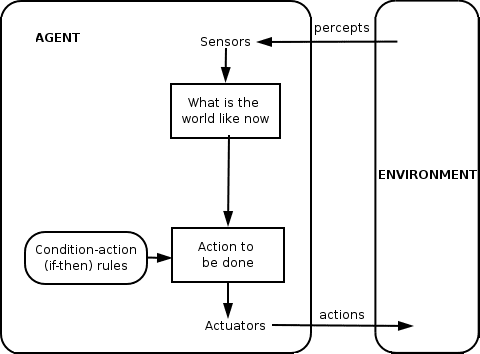 | ||
A multi-agent system (M.A.S.) is a computerized system composed of multiple interacting intelligent agents within an environment. Multi-agent systems can be used to solve problems that are difficult or impossible for an individual agent or a monolithic system to solve. Intelligence may include some methodic, functional, procedural approach, algorithmic search or reinforcement learning. Although there is considerable overlap, a multi-agent system is not always the same as an agent-based model (ABM). The goal of an ABM is to search for explanatory insight into the collective behavior of agents (which don't necessarily need to be "intelligent") obeying simple rules, typically in natural systems, rather than in solving specific practical or engineering problems. The terminology of ABM tends to be used more often in the sciences, and MAS in engineering and technology. Topics where multi-agent systems research may deliver an appropriate approach include online trading, disaster response, and modelling social structures.
Contents
Concept
Multi-agent systems consist of agents and their environment. Typically multi-agent systems research refers to software agents. However, the agents in a multi-agent system could equally well be robots, humans or human teams. A multi-agent system may contain combined human-agent teams.
Agents can be divided into different types ranging from simple to complex. Some categories suggested to define these types include:
Agent environments can be divided into:
Agent environments can also be organized according to various properties like: accessibility (depending on if it is possible to gather complete information about the environment), determinism (if an action performed in the environment causes a definite effect), dynamics (how many entities influence the environment in the moment), discreteness (whether the number of possible actions in the environment is finite), episodicity (whether agent actions in certain time periods influence other periods), and dimensionality (whether spatial characteristics are important factors of the environment and the agent considers space in its decision making). Agent actions in the environment are typically mediated via an appropriate middleware. This middleware offers a first-class design abstraction for multi-agent systems, providing means to govern resource access and agent coordination.
Characteristics
The agents in a multi-agent system have several important characteristics:
Self-organisation and self-steering
Multi-agent systems can manifest self-organisation as well as self-steering and other control paradigms and related complex behaviors even when the individual strategies of all their agents are simple. When agents can share knowledge using any agreed language, within the constraints of the system's communication protocol, the approach may lead to a common improvement. Example languages are Knowledge Query Manipulation Language (KQML) or FIPA's Agent Communication Language (ACL).
Systems paradigms
Many M.A. systems are implemented in computer simulations, stepping the system through discrete "time steps". The MAS components communicate typically using a weighted request matrix, e.g.
Speed-VERY_IMPORTANT: min=45 mph, Path length-MEDIUM_IMPORTANCE: max=60 expectedMax=40, Max-Weight-UNIMPORTANT Contract Priority-REGULARand a weighted response matrix, e.g.
Speed-min:50 but only if weather sunny, Path length:25 for sunny / 46 for rainy Contract Priority-REGULAR note - ambulance will override this priority and you'll have to waitA challenge-response-contract scheme is common in MAS systems, where
First a "Who can?" question is distributed. Only the relevant components respond: "I can, at this price". Finally, a contract is set up, usually in several more short communication steps between sides,also considering other components, evolving "contracts", and the restriction sets of the component algorithms.
Another paradigm commonly used with MAS systems is the pheromone, where components "leave" information for other components "next in line" or "in the vicinity". These "pheromones" may "evaporate" with time, that is their values may decrease (or increase) with time.
Properties
M.A. systems, also referred to as "self-organized systems", tend to find the best solution for their problems "without intervention". There is high similarity here to physical phenomena, such as energy minimizing, where physical objects tend to reach the lowest energy possible within the physically constrained world. For example: many of the cars entering a metropolis in the morning will be available for leaving that same metropolis in the evening.
The main feature which is achieved when developing multi-agent systems, is flexibility, since a multi-agent system can be added to, modified and reconstructed, without the need for detailed rewriting of the application. The systems also tend to prevent propagation of faults, self-recover and be fault tolerant, mainly due to the redundancy of components.
Study of multi-agent systems
The study of multi-agent systems is "concerned with the development and analysis of sophisticated AI problem-solving and control architectures for both single-agent and multiple-agent systems." Topics of research in MAS include:
Frameworks
While ad hoc multi-agent systems are often created from scratch by researchers and developers, some frameworks have arisen that implement common standards (such as the FIPA agent system platforms and communication languages). These frameworks save developers time and also aid in the standardization of MAS development. One such developmental framework for robotics is given in . See also Comparison of agent-based modeling software.
Applications in the real world
Multi-agent systems are applied in the real world to graphical applications such as computer games. Agent systems have been used in films. They are also used for coordinated defence systems. Other applications include transportation, logistics, graphics, GIS as well as in many other fields. It is widely being advocated for use in networking and mobile technologies, to achieve automatic and dynamic load balancing, high scalability, and self-healing networks.
